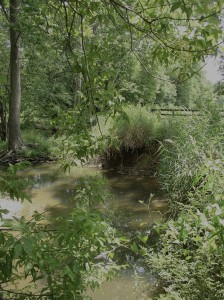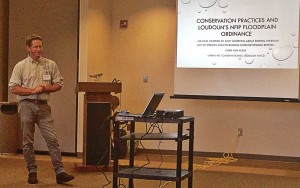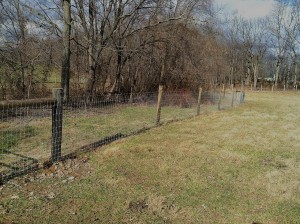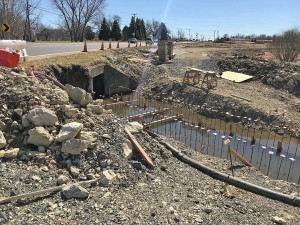
A healthy stream
Lovettsville’s Chris Van Vlack, an Urban/AG conservationist, with the Loudoun SWCD, made a presentation at the Potomac Watershed Roundtable about a recent FEMA policy, that Daniel Moore, from Virginia DEQ characterized as “flabbergasting.”
Greg Prelewicz, of Water and Wastewater Utilities, said he found it “baffling.”
It’s a FEMA policy that adversely affects Loudoun County’s efforts to preserve and protect our soil and water.

Chris Van Vlack at the presentation
The Potomac Watershed Roundtable Forum is “a regional government-citizen forum that promotes collaboration and cooperation among local governments and stakeholder interest groups,”
By way of background, Chris explained that there is a regular set of best management practices (BMPs) that keep our waters clean and flowing to the Potomac without eroding the rich soil so necessary to farm and garden.
It’s pretty straightforward.
Keep the animals (and their “nutrients”) out of the water, and plant cover crops and trees to slow the flow of water that might otherwise carry away the soil.
It’s so important a function that federal, state and local authorities, by conservation districts across Virginia and the nation, share the cost with farmers and land owners to make these remedial practices possible.
The cost of these practices are funded up to 80 percent of what it costs to fence in livestock from streams, to install water troughs, to implement livestock crossings, and to plant what restrains and controls surging rain waters.

Fencing by a stream
These best practices were instituted after the infamous tragedy of the dust bowl, so vividly described by John Steinbeck, in “Grapes of Wrath.”
It was the ignorance of right-minded soil and water practices that caused choking dust to block out the sun, sweeping the country in high winds from west to east, killing people, livestock, and crops.
Now FEMA says that Loudoun County may not use these salutary best practices in any flood plain. They convinced the County earlier this year to conform with what many of the speakers characterized as a wrong-headed policy. Continue reading →




